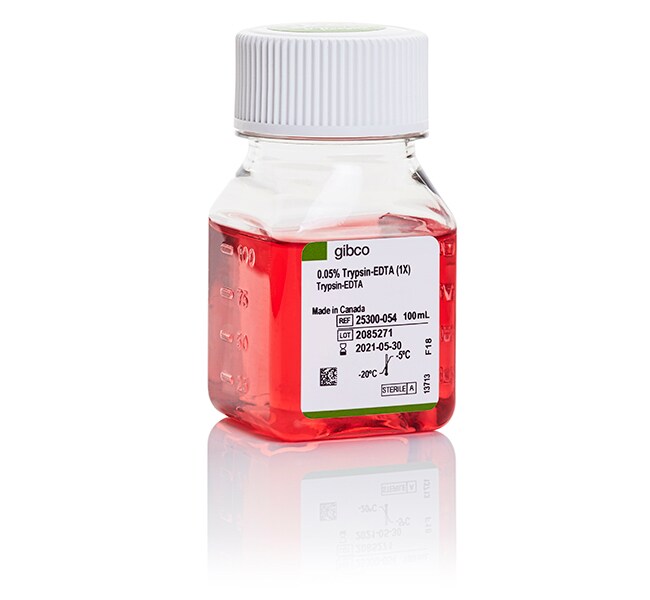Search Thermo Fisher Scientific

Gibco™
Trypsin-EDTA (0.05%), phenol red
Gibco Trypsin-EDTA is made from trypsin powder, an irradiated mixture of proteases derived from porcine pancreas. Due to its digestiveRead more
 Promotion
PromotionPromo code:RCELL25
Save up to 29% across the cell culture workflow - research begins with cells
From now until Dec 31, get up to 29% off media, sera, buffers, reagents and other cell culture products to advance your researchLearn More
| Catalog Number | Quantity |
|---|---|
25300054 | 100 mL |
25300062 | 500 mL |
25300120 | 20 x 100 mL |
Catalog number 25300054
Price (USD)
18.65
Online Exclusive
20.64Save 1.99 (10%)
Each
In stock
Quantity:
100 mL
Price (USD)
18.65
Online Exclusive
20.64Save 1.99 (10%)
Each
Gibco Trypsin-EDTA is made from trypsin powder, an irradiated mixture of proteases derived from porcine pancreas. Due to its digestive strength, trypsin is widely used for cell dissociation, routine cell culture passaging, and primary tissue dissociation. The trypsin concentration required for dissociation varies with cell type and experimental requirements. See the complete range of Gibco trypsin solutions and recommended dissociation conditions.
We offer a variety of trypsin formulations and animal origin-free TrypLE reagent that feature:
• Quality Testing
• Documented Traceability
• Dual-site cGMP Manufacturing
This trypsin solution is modified as follows:
With
• EDTA
• Phenol Red
The complete formulation is available.
Quality Testing
Gibco Trypsin solutions are tested for pH, osmolality, sterility, and performance. In addition, the raw materials are verified for e-beam irradiation and precursor lots are tested for endotoxin, PPV, PCV 1/2, mycoplasma, bacterial, fungal, and viral contamination, as well as multiple activity assays, ash analysis, and moisture analysis.
Documented Traceability
We can provide detailed documentation to meet your regulatory needs. Gibco Trypsin information available includes lot traceability, animal origin certificates, lot analyses, irradiation certificates, a viral inactivation summary, and supply chain transparency.
cGMP Manufacturing and Quality System
For supply chain continuity, we manufacture Gibco Trypsin-EDTA (0.05%), phenol red at two separate facilities located in Grand Island, NY and Scotland, UK. Both sites are compliant with cGMP manufacturing requirements and are certified to the ISO 13485 standard.
We offer a variety of trypsin formulations and animal origin-free TrypLE reagent that feature:
• Quality Testing
• Documented Traceability
• Dual-site cGMP Manufacturing
This trypsin solution is modified as follows:
With
• EDTA
• Phenol Red
The complete formulation is available.
Quality Testing
Gibco Trypsin solutions are tested for pH, osmolality, sterility, and performance. In addition, the raw materials are verified for e-beam irradiation and precursor lots are tested for endotoxin, PPV, PCV 1/2, mycoplasma, bacterial, fungal, and viral contamination, as well as multiple activity assays, ash analysis, and moisture analysis.
Documented Traceability
We can provide detailed documentation to meet your regulatory needs. Gibco Trypsin information available includes lot traceability, animal origin certificates, lot analyses, irradiation certificates, a viral inactivation summary, and supply chain transparency.
cGMP Manufacturing and Quality System
For supply chain continuity, we manufacture Gibco Trypsin-EDTA (0.05%), phenol red at two separate facilities located in Grand Island, NY and Scotland, UK. Both sites are compliant with cGMP manufacturing requirements and are certified to the ISO 13485 standard.
Specifications
Cell TypeMammalian Cells
ChelatorsEDTA
Concentration1 X
Osmolality270 - 310 mOsm/kg
Product LineGibco™
Quantity100 mL
Shelf Life24 Months
Shipping ConditionWet ice
SourceAnimal Origin
Tested ForIn vitro Bioassay
ClassificationAnimal Origin
FormLiquid
Product TypeCell Culture Dissociation Reagent
SterilitySterile-filtered
Sterilization MethodSterile-filtered
With AdditivesPhenol Red, EDTA
pH7.1 to 8
Unit SizeEach
Contents & Storage
Storage conditions: -5°C to -20°C
Shelf life: 24 months from date of manufacture
Shelf life: 24 months from date of manufacture

Follow the 5 steps to publication-quality fixed-cell imaging.
Download your free 5-step guide today ›
Media Formulations
